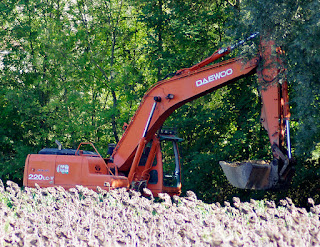Just recently, a big poster appeared by the Aigronne bridge, advertising
aménagements du lit (improvements to the riverbed).
 |
| Aménagements du lit |
Then a succession of dumper trucks began clattering to and fro past the house, delivering their contributions to a series of piles of white stone, mainly small but including some very big ones. At peak there were four different trucks passing at approximately quarter-hourly intervals. Then a big digger arrived and started nibbling away at the stones, depositing it carefully on the river bed between Gatault downstream of us and Le Moulin de Chevarnay upstream.
We had learned of the plan to improve the flow of the rivers and streams that make up the Claise basin at the Fête de la Chasse at Preuilly sur Creuse, but we hadn't appreciated that it was going to happen so soon. As Yohann Sionneau, the river technician, explained to us, many of the river banks in our area are effectively canalised in places, the numerous poplar trees at even spacings with every trace of cover for small wildlife scrupulously removed. The flow is too smooth and uniform between these pared-down banks, reducing thediversity of habitat. In places the bed has become too wide, so during periods of reduced flow, particularly in summer, the water becomes very shallow, reducing the oxygen levels. There is also too much silt, denying the fish access to the gravel beds where they spawn. All these factors diminish the biodiversity of the Aigronne. The project was financed by the water authority for the Loire and Brittany; the prefecture of Region Centre; and the community of communes of Touraine du Sud.
Using the stones, shingle banks and rocky outcrops have been created, so that the flow rate and depth of water are more varied. Increased turbulence allows the water to pick up more oxygen. When water levels are lower, the shingle banks reduce the width of the channel, so that such water that
does flow is deeper. Thus the river bed is improved for wildlife, especially aquatic species such as - er - trout. Oh what a giveaway.
 |
| Destined for the riverbed |
The work was done by a large digger and, whilst the large stones were dumped on the side, the main loads of smaller calcaire were dumped directly into the river. The digger then collected a bucket load and took it to where it was to be used.
This did make the river very cloudy to begin with as the powdered calcaire was washed out... but the river is now nice and clean again. We'll put up more shots of these bits over the seasons.
![Parasol Mushroom [PK74339]](http://farm7.staticflickr.com/6215/6371224339_c61262952f_z.jpg)




































